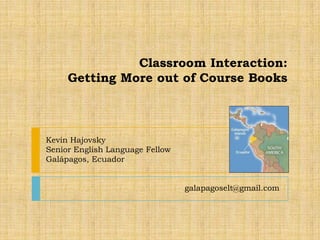
[RELO] Classroom Interaction: Getting More out of Course Books
- 1. Classroom Interaction: Getting More out of Course Books galapagoselt@gmail.com Kevin Hajovsky Senior English Language Fellow Galápagos, Ecuador
- 2. Webinar Objectives “Course books are proposals for action, not instructions for use.” (Harmer, 2001) Build our awareness of positive and negative aspects Learn & share strategies and techniques for effective use PLEASE SHARE YOUR IDEAS!
- 3. Focus Question #1 In your opinion, what are the advantages and disadvantages of using course books?
- 4. Potential Advantages Provide structure to class or semester (vocabulary, grammar, and content) Guide class with sense of accomplishment Work as a starting point for extension activities Save a lot of preparation time Often expected by learners in schools (Dalby, 2009)
- 5. Potential Disadvantages Creativity can be limited Quality, design, or organization can be poor Topics can be boring or irrelevant Contexts or content may not be culturally relevant Language is often inauthentic (Dalby, 2009)
- 6. Focus Question #2 What general kinds of techniques do you use to create more learner-centered interaction with course books?
- 7. Key Techniques for Creating Interaction How students are seated immediately affects how they interact. versus
- 8. Key Techniques for Creating Interaction Using your whiteboard effectively: clarify how to use the language, provide support in the tasks Sentence Starters Models of language Language to guide or for students to exploit Key words of instructions Focus questions Sentence patterns Brainstormed lists of words
- 9. Focus Question #3: The Big Question! What are some of your specific strategies, ideas and techniques for using course books more effectively? …difficulties arise when we try to use textbooks exactly as they are, without thinking about the needs, skills and circumstances of the particular set of students sitting in front of us.” (Elliott, 2010)
- 10. Major Ideas Considered Here Use of books’: pictures (+other pictures) texts exercises + Key Techniques for Creating Interaction
- 11. Building Interaction: Pictures Focus Question #4: How do you use course book pictures in your classes? “A picture is worth a thousand words.” ~Unknown
- 12. Building Interaction: Pictures With the picture(s) in front of them, contextualize lesson by having students: make predictions about text ask and answer questions describe talk and/or speculate about (meaningful to students) share their own (personalize) knowledge of opinions of likes/dislikes preferences cultural comparisons role play (as if in the picture) (Dalby, 2009; Tanner & Green, 1998; Witherspoon, 2012)
- 13. Building Interaction: Pictures Use pictures of students’ own country/city (meaningful, relevant, and personal) Can adapt to course book settings and improvise. E c u a d o r (Baumgardener & Kennedy, 1995)
- 14. Building Interaction: Pictures Use Tasks + Pictures Topics of Interest and/or Related to Learners’ Actual Lives • People • Places • Things • Contexts • Actions • History • Music • Food • Clothes • Holidays • Special events • Customs and traditions • Culture • Sports • Sterotypes • Common occurences • Climate • Religion • Politics (Baumgardener & Kennedy, 1995)
- 15. Building Interaction: Texts (Conversation or Reading) Focus Question #5: How do you utilize conversations or reading texts in your classes?
- 16. Building Interaction: Texts (Conversation or Reading) Predict/connect what’s in the text (with pictures) Copy and cut up the texts, students order them Running or shouting dictations, or dictoglosses Students add/change words in conversations for own social contexts (adjectives, adverbs, local vocabulary, etc.) Students draw and fill out graphic organizers together (Dalby, 2009; Scionis, 1990; Tanner & Green, 1998; Witherspoon, 2012)
- 17. Building Interaction: Texts (Conversation or Reading) Students imagine before or after a story or conversation Students compare and discuss answers to comprehension questions Students personalize by giving advice and point of views, or stating similarities/differences, preferences, etc. Vary setting, mood, or characters of conversation to add creativity Role play or act out in pairs or small groups (with pictures as settings?) (Dalby, 2009; Scionis, 1990; Tanner & Green, 1998; Witherspoon, 2012)
- 18. Building Interaction: Exercises Focus Question #6: How can we use the exercises in course books more effectively in classes?
- 19. Building Interaction: Exercises Students do and/or check answers in pairs/groups (before and/or after practice or drills) Students ask class for clarification as needed (teacher oversees only) Teams make questions to elicit answers from other teams Make a quiz game for checking answers (multiple- choice, right/wrong) Copy and cut up exercises to make a team race game Students act out or draw answers (Charades/ Pictionary) while other General Goal: Give students more interaction time & transfer responsibility for learning to them. (Dalby, 2009; Sionis, 1990; Tanner & Green, 1998; Witherspoon, 2012)
- 20. In Summary Learner- centered Interaction Book’s Pictures Book’s Texts Book’s Exercises Pair work & Group Work Whiteboard techniques Pictures of local context
- 21. Bibliography *Baumgardner, R.J. and Kennedy, A.E. (1995) The use of local contexts in the design of EST materials. In Creative Classroom Activities: English Teaching Forum 1989-1993, ed. T. Kral, Office of English Language Programs, Washington, D.C. Dalby, T. (2009). Adapting your course book: Becoming skilled in the art of manipulation. TESOL Review, 1, 145-166. Elliott, David (2010) The coursebook challenge. English Teaching Professional, 69, July 2010 Harmer, J. (2001) Coursebooks: A human, cultural and linguistic disaster? Modern English Teacher, 10(3), 5-10. Harmer, J. (2010) How to teach english. Pearson Education Limited, Essex, England. *Sionis, C. (1995) Let them do our job! Towards autonomy via peer-teaching and task-based instruction. In Creative Classroom Activities: English Teaching Forum 1989-1993, ed. T. Kral, Office of English Language Programs, Washington, D.C. Tanner, R. and Green, K. (1998) Tasks for teacher education: A reflective approach. Pearson Education Limited, Essex, England. Witherspoon, J. (2012) English comes alive! Dynamic, brain-building ways to teach ESL and EFL. Synapse Books, Bryan, Texas, USA. *Free Downloadable Book and other materials on the American English website! http://americanenglish.state.gov/resources/creative-classroom-activities
Editor's Notes
- Exercises are usually done individually. How can we create more interaction with the exercises in class?
